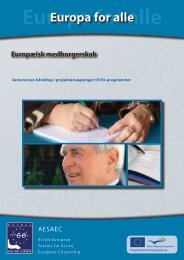We All are Europe - AESAEC
We All are Europe - AESAEC
We All are Europe - AESAEC
You also want an ePaper? Increase the reach of your titles
YUMPU automatically turns print PDFs into web optimized ePapers that Google loves.
Module 5 – The Art of Successful Project Proposal Writing II: Linguistic Part<br />
non-verbal<br />
(mimicking, gestures,<br />
silence)<br />
verbal<br />
(all forms that <strong>are</strong><br />
expressed with the help<br />
of words)<br />
Communication<br />
paraverbal<br />
(flow of words, speed of<br />
speech, length of<br />
pauses)<br />
extraverbal<br />
(clothing, smell,<br />
external characteristics)<br />
A person can express himself / herself non-verbally as well as verbally. Verbal signals must first be<br />
learnt in order to understand them and to be able to use them. This takes place in the first years of<br />
life. Our environment determines not only the accent and tone of our speech, but also the content<br />
which we connect with individual words. Thus when a mother in Sweden asks her child to think of a<br />
large animal the child would very likely think of a reindeer whereas a child in Africa might have an<br />
elephant in mind.<br />
However, our messages <strong>are</strong> not only be transported by different means, they can also include different<br />
information, background knowledge etc.<br />
Some linguists say that each message consists of up to four different aspects, which <strong>are</strong>:<br />
• the direct message, in which I pass on information<br />
• the self-disclosure message gives information about what is happening with me and what I<br />
want to be made known about me<br />
• the appeal states what I want of the other person<br />
• the indirect message, with which the sender conveys the relationship to the receiver<br />
For example, a person says to another person: “Can you lend me 20 Euros please”<br />
The direct message reads: I would like to borrow 20 Euros.<br />
The self-disclosure message says: I urgently need 20 Euros and I do not have them myself.<br />
The indirect message conveys: <strong>We</strong> have a close relationship and I would not borrow money from<br />
just any person.<br />
The appeal means: I would very much appreciate to be lent 20 Euros.<br />
Of course, it not always easy to differentiate between these four messages. However, usually the<br />
sender gives a message with these four aspects, which the receiver picks up. It can happen that the<br />
receiver does not pick up all four aspects of the message at the same level of intensity as that intended<br />
by the sender. It can also occur that the receiver does not understand or wrongly interprets<br />
one, more or even all aspects of the message – this is also called a misunderstanding!<br />
Persons, due to their life experience, apply their own ideas in a communication situation. Remember<br />
the short story above: Although the good friends both speak about a holiday they have a totally<br />
85









